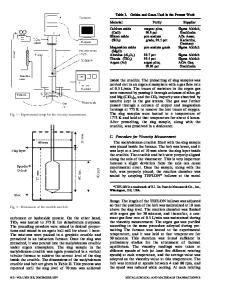Experimental Study on the Formation of V-Rich Spinel Phase in CaO-SiO 2 -MgO-FeO t -Al 2 O 3 -V 2 O 3 -P 2 O 5 Slags at
- PDF / 1,331,721 Bytes
- 7 Pages / 593.972 x 792 pts Page_size
- 96 Downloads / 281 Views
NTRODUCTION
VANADIUM is vital as an alloy additive in the steel industry and as an important catalyst component in the chemical industry. Market demand for vanadium products has grown sustainably in recent years, and further future growth is anticipated. Vanadium is the twenty-second most abundant element in the Earth’s crust, but it rarely forms deposits on its own and it occurs in combination with various minerals, such as coulsonite and vanadium titano-magnetite.[1] The vanadium that is hosted in magnetite is enriched in the slag during steelmaking, and vanadium-bearing slag that contains 2 to 4 mass pct V2O5 is obtained.[2] Vanadium-bearing stone coal, as a minor source of vanadium production, is a carbonaceous shale type with 0.3 to 1.2 mass pct V2O5, which is interpreted to be of sedimentary syngenetic origin. Although the vanadium
LIUSHUN WU, CUNJUN QI, JUE WANG, and YUANCHI DONG are with the School of Metallurgical Engineering, Anhui University of Technology, Maanshan 243032, Anhui, P.R. China. BAIJUN YAN is with the School of Metallurgical and Ecological Engineering, University of Science and Technology Beijing, Beijing 100083, P.R. China. Contact e-mail: [email protected] Manuscript submitted March 9, 2018.
METALLURGICAL AND MATERIALS TRANSACTIONS B
grade of stone coal is low, its large resource reserves and wide distribution[3,4] make it possible as a major feedstock for future vanadium production. To recover vanadium from steelmaking slag and stone coal ore, oxidation roasting followed by acid or alkali leaching is generally adopted in industry.[5–8] However, the low vanadium grade of the feedstocks causes insurmountable problems of energy consumption and environmental pollution. For instance, the huge feedstock tonnage gives rise to extra energy, acid or alkali consumptions, and consequent exhaust and effluent production. To improve the vanadium grade, some traditional separation methods, such as gravity- and magnetic-separation methods, have been attempted. Unfortunately, these methods have little effect because of the dispersed occurrence of vanadium in various minerals. In view of the above-mentioned problems, the selective-precipitation method was proposed to reprocess vanadium-bearing steelmaking slag, which was aimed at changing the disperse occurrence of vanadium and to form vanadium-rich minerals in the slag.[9] For example, Ca3(V,P)2O8 and Ca3(V,P)2O8ÆnCa2SiO4 vanadium-rich solid–solution phases were precipitated in vanadium-bearing steelmaking slag by modifying the slags using Al2O3, SiO2, and MgO, and recrystallizing at high temperature.[10,11] The separation of precipitated vanadium-rich phases from the remaining slag minerals is challenging, because the physical properties of the precipitated vanadium-rich phases are very similar to those of the other minerals in the slags.
To solve the separation problem, a magnetic spinel phase that was composed of iron and vanadium oxides was designed as the vanadium-rich phase in our research group. In this new method, iron oxide reacted with vana
Data Loading...











